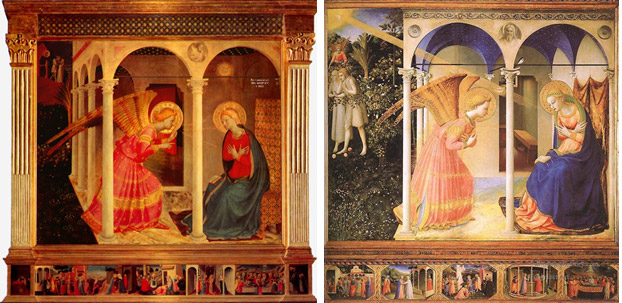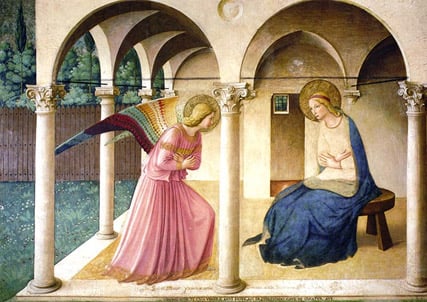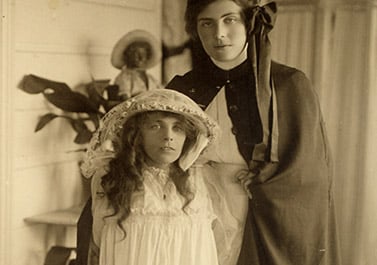HOMILY FOR VOTIVE MASS OF OUR LADY IN COMMEMORATION OF SERVANT OF GOD EILEEN O’CONNOR

Today’s Gospel scene (Lk 1:26-38) is one of the most memorable in the Bible and has inspired great artists for centuries. My favourite is, unsurprisingly, a Dominican artist, who is also patron of artists, Fra Angelico. He produced about a dozen Annunciations, from miniatures in manuscripts to altarpieces and wall frescoes. It’s remarkable what a variety of portrayals we have of that simple scene. The late mediaevals differentiated successive stages of the Annunciation story – ‘the Salutation’, ‘the Mission’, ‘the Colloquy’ and so on – each with several distinct moments. During the Colloquy, for instance, Mary was said to have experienced five consecutive spiritual conditions: disquiet, reflection, inquiry, submission and merit. For painters this was a goldmine of inspired possibilities. The Virgin Annunciate could sit quiet in contemplation, recoil in fear, kneel in humility, engage in interrogation, or sit upright as queen enthroned.
Each painting captures something of this extraordinary event in the history of salvation. Likewise our readings today make the Annunciation the hinge between the old and the new covenants (Mic 5:1-4; Eph 1:3-6, 11-12; Lk 1:26-38): for at this moment the prophecies of old find their fulfilment, and the excitement of the new takes form. St Gabriel speaks in the voice of the Old Testament when he tells Mary that her boy will be Son of the Most High God, successor of King David, and ruler over the House of Jacob. Mary, who in Fra Angelico’s works generally has a book of the Scriptures on a lap, would have understood such words as referring to the long hopes of Israel and the promises of the Prophets.
Today’s Gospel story of the Annunciation to Mary provides an interesting parallel and contrast with that of the Annunciation to Zechariah. ‘Do not be afraid’, the angel Gabriel tells them both, as both were naturally disturbed by the appearance of God’s messenger. When they are promised their miraculous conceptions, both wonder and even question the angel. But here we arrive at a strange difference: Zechariah is punished for his questioning while Mary is praised. Is God just playing favourites because He has a soft spot for His soon-to-beMother?

Looking carefully at the text, however, we realize that the two conversations go very differently. Gabriel does not greet Zechariah, for he is Zechariah’s superior. But he salutes Mary as “Hail, full of grace, the Lord is with thee!” and in Fra Angelico’s images he genuflects before her. When the priest says to us at Mass ‘Dominus vobiscum – The Lord be with you’ he is expressing the aspiration and prayer ‘May the Lord be with you’. But when the angel says Dominus tecum to Mary he’s stating a fact: The Lord is with you. As St. Augustine pointed out, the angel is saying the Lord “is more with you [Mary] than He is with me: He is in your heart, He takes shape within you, He fills your soul, He is in your womb.”[i] No wonder the Archangel kneels before her so often in art and she sits or stands above him as Queen of angels.
Another interesting contrast is between the way Zechariah doubts the very possibility of his wife conceiving, while Mary, accepting God can do anything, simply asks how God will bring it about. Zechariah is resisting faith while Mary is deepening hers. So as St John Paul II pointed out, such searching questioning is the first aspect of true faithfulness.[ii] Mary rightly seeks to understand God’s plan for her and for the world – but she does so while expressing her willingness to follow that plan, however mysterious it remains…between

‘How can this be?’ asked Mary. I’m a virgin. I’m from Nowheresville. I’m no-one important. How can I be Mother of God? How can God become human? And why would he? What would we even call such a child? Mary had her questions and so must we. Eileen O’Connor surely have had hers also. As a young child not only did she suffer a accident that left her permanently damaged, dwarfed, debilitated and distressed, but she was raised at times in extreme poverty. Faced with such suffering, she might have wondered as Christ did, ‘My God, have you abandoned me?’
In her adult years the little mother suffered not only physically, but also emotionally, through the judgment and uncooperativeness of those who could not see beyond her disabilities to her potential, or beyond her ordinariness to the mystic within. Again, she must often have asked herself or her God: why?
Though she joined Mary in asking God what and how and why, Eileen never joined Zechariah in doubting that God can act. She chose, like that Blessed Mother whom she knew and loved so closely, to made her challenges into opportunities to ponder, to pray, to deepen her faith, and then to act.
Like Our Blessed Mother, ‘the Little Mother’ submitted with the words ‘I God’s handmaid: let it be done to me according to your word’, ‘Your kingdom come, your will be done’, ‘Though I wouldst that you take this cup of woe from me, not my will be done but yours.’ For such faithful prayer and pondering and saying YES amidst the mystery of suffering, this little lady was able to achieve far more in 28 years than most able-bodied people do in 128 years! I can think of no better example of someone who received the loving Word of God, if not into her womb, into her heart and soul and entire being; where it multiplied it, so she might pass in on to others and ensure that they were cared for.
The Church in Sydney and beyond today still benefits from Eileen’s fiat, just as the worldwide Church still benefits from Mary’s. By it the love of God becomes incarnate in the lives of some of Sydney’s most vulnerable, through the compassionate care of Our Lady’s Nurses of the Poor for those in need. So to all those who continue Eileen’s great work, I say: thank you for your Fiat to God. Thank you for your leadership and service. Together let us pray that the Little Mother may be raised to be counted among the saints in heaven.
INTRODUCTION TO VOTIVE MASS OF OUR LADY IN COMMEMORATION OF SERVANT OF GOD EILEEN O’CONNOROur Lady’s Home, 35 Dudley St, Coogee, 10 January 2019
Welcome all to this commemoration of the anniversary of the death of Eileen O’Connor – whom we hope one day to call Australia’s second saint! Eileen shared with Mary MacKillop a love of Christ, of the Church, of the poor and of religious life. Yet if they had their similarities there were also complementary differences: Mary was a consecrated religious, Eileen a lay woman; Mary was fit and hearty, Eileen disabled and sickly; Mary focused mostly on the care of the healthy, Eileen on the care of the sick, frail and elderly; Mary was the builder of a religious empire, Eileen rather shorter in her aspirations!
Last year I appointed a postulator for the process of Eileen’s beatification and canonisation for Eileen, and the Holy See, in confirmation of the work done so far, gave her the title ‘Servant of God’. We pray now that the Church may eventually raise her to the altars as a saint, and that my her intercession before her loving Lord there may be many miracles to credit to that cause.
I thank Sr Gabriel and all Our Lady’s Nurses for their welcome to Sr Clare and the Sisters of Charity who are assisting with governance of the congregation, to Bishops Tony, David and myself, to my brother priests and fellow religious, and to us all, and Sr Margaret Mary for her words of introduction.
[i] St. Augustine, Sermo de Nativitate Domini, 4
[ii] John Paul II, Homily, Cathedral of Mexico City, 26 January 1979 http://w2.vatican.va/content/john-paul-ii/en/homilies/1979/documents/hf_jp-ii_hom_19790126_messico-cattedrale.html

